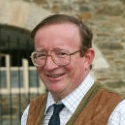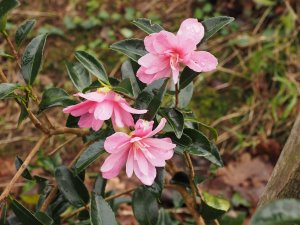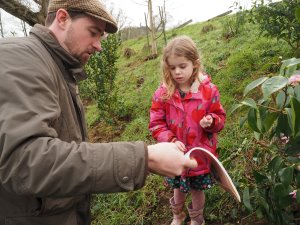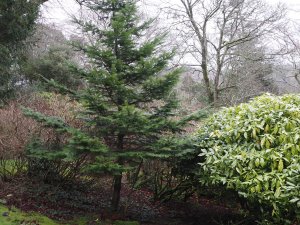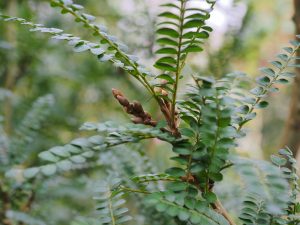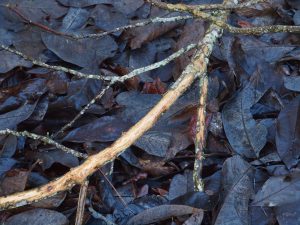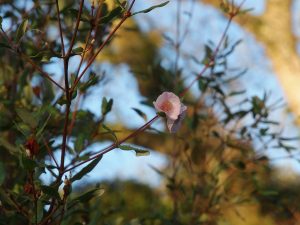2025 – CHW (images to follow)
2024 – CHW
Cloudy and still warm.
A trip to take Bea to see her Camellia sasanqua plantation (plaque awaited).
Bea and John with Camellia sasanqua ‘Bonanza’.


I will not be laughing at long Covid in a hurry after today, finally feeling rather more normal and less tired. A Christmas to forget if ever there was one. Grim and dispiriting. Furthermore today I finally discover that Andrew Leslie died just before Christmas. Andrew was a Garden Society Member and President/ Show Director of the Cornwall Garden Society. A serious gardening friend who will be greatly missed in many ways.The very first flowers out in the sun today on Rhododendron mucronulatum below the big Fernery.
Acacia baileyana is the first species to flower here this time around. Others are near but not quite yet. We have 6 species planted out. I remember a huge Acacia dealbata below the lawn but it died 50+ years ago.
Attached is the final list of Malus species and varieties to plant out shortly in the Old Kitchen Garden with approximate ultimate/ mature heights as far as I can identify them from John L Fiala’s 1994 published reference book on ‘Flowering Crabapples – The Genus Malus’ and Hilliers etc.

The planting plan (also attached) tries to take account of ultimate heights and spreads of each group of three trees in the context of the layout of the Old Kitchen Garden and how visitors will view these trees form above, beside and across the valley from the main paths.
By no means all the varieties are listed in Fiala’s book or, indeed, in more recent reference books so I have had to guess a bit about mature heights.
The basic rule of thumb for spacing the trees out for planting will be:-
– 4 metre spacing for smaller growing varieties – 12ft eventually and columnar
– 6 metre spacing for medium growing varieties –c. 20ft x 20ft eventually
– 7 metre spacing for tallest growing varieties – c. 30ft x 30ft eventually
– 6 metre spacing for weeping/ spreading growing varieties
There should be plenty of space to add more varieties than the 65 in the first wave of planting (180 trees). I have included a few Pyrus in the plan because of their close association to and similarities in flowering to Malus.
This is clearly a huge subject and there are scores if not hundreds more varieties to source over time. However, since most of the flowering Malus breeding has taken place in the US, we will not be able to source them from there. I dare say we may have a few duds in the collection already, which are not worth their place but the challenge of working towards a National Collection application one day well into the future will be entertaining and fun.
It should all be quite a spectacle quite quickly barring the usual horticultural disasters.
2021 – CHW
Rhododendron nobleanum now full out on the drive.


Blustery but less cold.Camellia x williamsii ‘Rosemary Williams’ has survived the gales.
An overcast but warmish day.First two primroses in flower opposite the front door. I had to look quite hard as a cock pheasant has been eating them.
Sophora japonica ‘Sun King’ has a fat crop of flower buds developing. We lost three of these in cold winds by the Playhouse in 2012 but this plant is well protected at the top of the garden.
Reports of a ‘large’ tree blown over near the top lodge prove to be not that exciting. It is only yet another of our 10 to 12 year old specimen ilex oaks which has gone over in today’s filthy gales and rain.
Camellia x williamsii ‘George Blandford’ is now full out in the sun. George’s ashes were scattered underneath the bush 45 or so years ago. Almost a hint of blue in the petals and a different shape to ‘Caerhays’ which is not out yet.



Nearby a young Magnolia ‘Caerhays Belle’ which I photographed six weeks ago with what I thought was a secondary flower or two has now lost its buds although old seed pods remain. So it actually tried to come out in December and got its spring show blown and rained away. It looks like frost damage but we have not had any!
How much more bonkers is this season going to get and will we yet pay for it?
2003 – FJW
First frost of winter – not much – [Camellia sasanqua] ‘Winter Intruder’ at its best.
2000 – FJW
Snow started 9.55am – first sizeable fall for some years.
1998 – FJW
R. John Williams killed 5 pheasants and a woodcock at Slyde Park with 4.10
1996 – FJW
A very late year. Dry cold December – gradually increasing frosts. No flowers on Noblissima.
1950 – CW
A lot of snow and frost lately and very little out bar camellias. Flowers of Taliensis brown when opened but buds open well in water.. Fuchsias all gone. Some of the young shoots of Cam sasanqua brown – Taliensis not touched. Camellia saluenensis out in several places.
1947 – CW
Mucronulatum and Nobleanum out also 3 or 4 of the Sutchuenense hybrids, bits of Yellow Hammer and Golden Oriole and Moupinense. Hamamelis only beginning. Camellia Double white been out 2 weeks and the first J.C.W bud (opening) picked today. Oleifera very good still. Bits is Cam sasanqua left. Pink Saluenensis by Tin Garden good and other bits beginning. A few lapagerias. No fuchsias.
1942 – CW
Rho mucronulatum very good. Nobleanum also. Several other small bits and the Rookery Sutchuenense Arboreum out. Hamamelis at its best but Cam oleifera the best thing now. Several of the hybrids good and the Engine House double white out. Some fuchsias and lapagerias out also [?]Ballsing.
1925 – JCW
Hamamelis mollis are very fine indeed, very little else, but there are small bits of rhodo’s out just as usual.
1918 – JCW
Aconite showing. Snowdrop.
1902 – JCW
A great move in the two and three year old daffs during the week.

